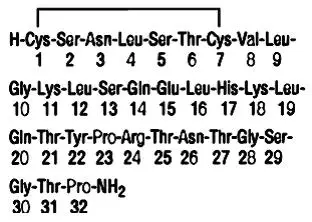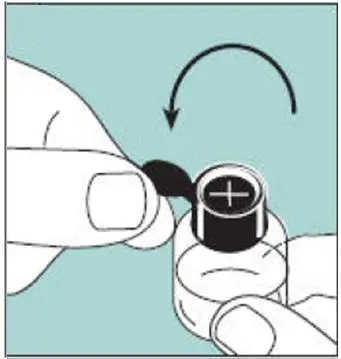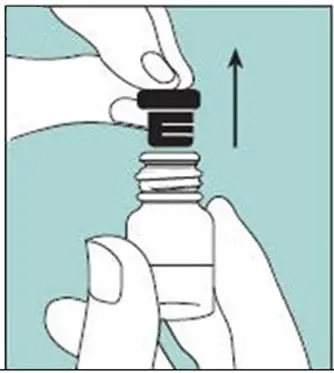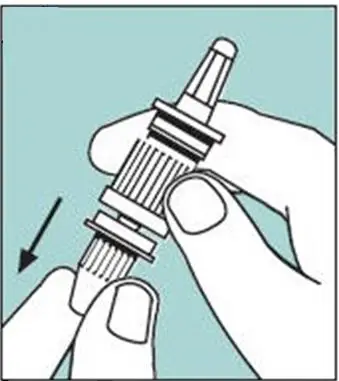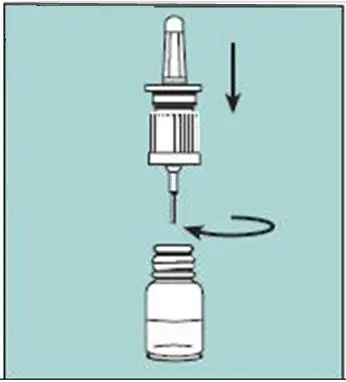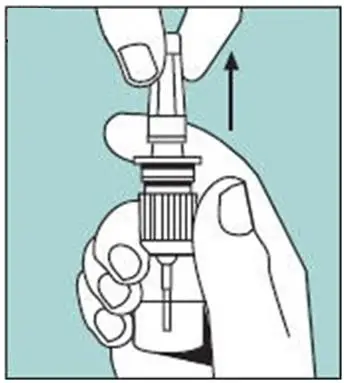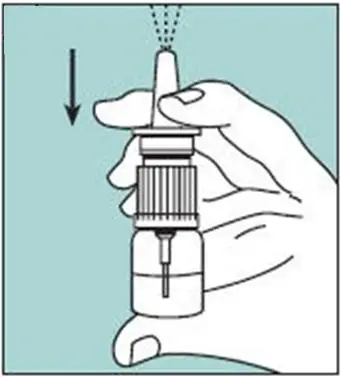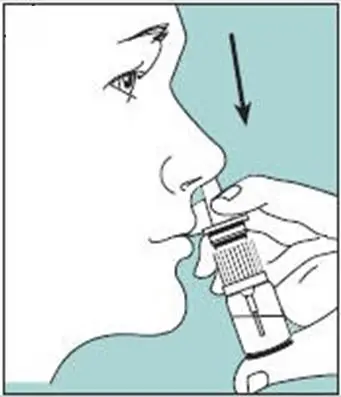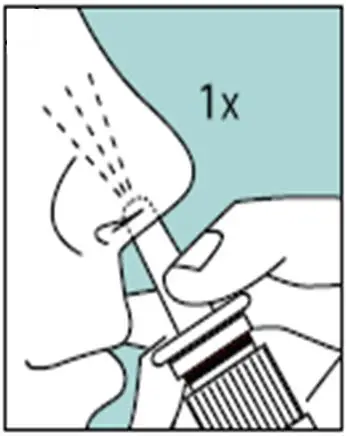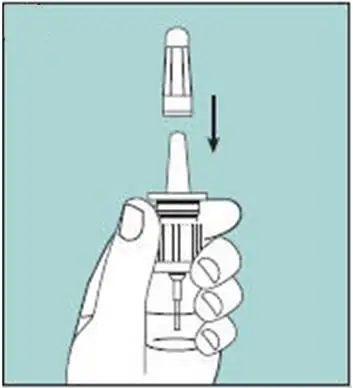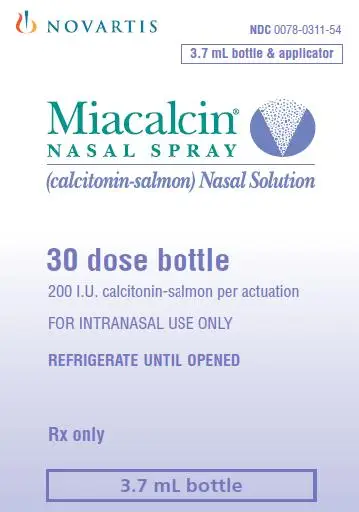Drug Detail:Miacalcin nasal (Calcitonin nasal [ kal-si-toe-nin ])
Drug Class: Calcitonin
Highlights of Prescribing Information
MIACALCIN® (calcitonin-salmon) nasal spray, for intranasal use
Initial U.S. Approval: 1975
Recent Major Changes
Indications and Usage (1.2) 3/2014
Warnings and Precautions (5.4) 3/2014
Indications and Usage for Miacalcin Nasal Spray
Miacalcin nasal spray is a calcitonin, indicated for the treatment of postmenopausal osteoporosis in women greater than 5 years postmenopause when alternative treatments are not suitable. Fracture reduction efficacy has not been demonstrated (1.1)
Limitations of Use:
- Due to the possible association between malignancy and calcitonin-salmon use, the need for continued therapy should be re-evaluated on a periodic basis (1.2, 5.4)
- Miacalcin nasal spray has not been shown to increase bone mineral density in early postmenopausal women (1.2)
Miacalcin Nasal Spray Dosage and Administration
- For intranasal use only: one spray (200 International Units) per day, alternating nostrils daily (2.1)
- Prior to first use, allow the bottle to reach room temperature and prime the pump (2.2)
- Ensure adequate calcium and vitamin D intake (2.3)
Dosage Forms and Strengths
Nasal Spray: 2200 International Units per mL of calcitonin-salmon in a 3.7 mL fill glass bottle with screw-on pump. Each actuation delivers 200 International Units of calcitonin-salmon (3)
Contraindications
Hypersensitivity to calcitonin-salmon or any of the excipients (4)
Warnings and Precautions
- Serious hypersensitivity reactions including anaphylactic shock have been reported. Consider skin testing prior to treatment in patients with suspected hypersensitivity to calcitonin-salmon (5.1)
- Hypocalcemia has been reported. Ensure adequate intake of calcium and vitamin D (5.2)
- Nasal adverse reactions, including severe ulceration can occur. Periodic nasal examinations are recommended (5.3)
- Malignancy: A meta-analysis of 21 clinical trials suggests an increased risk of overall malignancies in calcitonin-salmon-treated patients (5.4, 6.1)
- Circulating antibodies to calcitonin-salmon may develop, and may cause loss of response to treatment (5.5)
Adverse Reactions/Side Effects
Most common adverse reactions (3% or greater) are rhinitis, epistaxis and other nasal symptoms, back pain, arthralgia, and headache (6)
To report SUSPECTED ADVERSE REACTIONS, contact Novartis Pharmaceuticals Corporation at 1-888-669-6682 or FDA at 1-800-FDA-1088 or www.fda.gov/medwatch.
Drug Interactions
- Concomitant use of calcitonin-salmon and lithium may lead to a reduction in plasma lithium concentrations due to increased urinary clearance of lithium. The dose of lithium may require adjustment (7)
Use In Specific Populations
- There are no data to support use in children (8.4)
- Nasal reactions are more common in elderly patients (8.5)
See 17 for PATIENT COUNSELING INFORMATION and FDA-approved patient labeling.
Revised: 3/2014
Full Prescribing Information
1. Indications and Usage for Miacalcin Nasal Spray
1.1 Treatment of Postmenopausal Osteoporosis
Miacalcin nasal spray is indicated for the treatment of postmenopausal osteoporosis in women greater than 5 years postmenopause. Fracture reduction efficacy has not been demonstrated. Miacalcin nasal spray should be reserved for patients for whom alternative treatments are not suitable (e.g., patients for whom other therapies are contraindicated or for patients who are intolerant or unwilling to use other therapies).
1.2 Important Limitations of Use
- Due to the possible association between malignancy and calcitonin-salmon use, the need for continued therapy should be re-evaluated on a periodic basis [see Warnings and Precautions (5.4)].
- Miacalcin nasal spray has not been shown to increase spinal bone mineral density in early postmenopausal women.
2. Miacalcin Nasal Spray Dosage and Administration
2.1 Basic Dosing Information
The recommended dose of Miacalcin nasal spray is 1 spray (200 International Units) per day administered intranasally, alternating nostrils daily.
2.2 Priming (Activation) of Pump
Unopened Miacalcin nasal spray should be stored in the refrigerator. Before using the first dose of Miacalcin nasal spray, the patient should wait until it has reached room temperature. To prime the pump before it is used for the first time, the bottle should be held upright and the two white side arms of the pump depressed toward the bottle, repeat until a full spray is released. The pump is primed once the first full spray is emitted. To administer, the nozzle should first be carefully placed into the nostril while the patient’s head is in the upright position, then the pump should be firmly depressed toward the bottle. The pump should not be primed before each daily dose.
3. Dosage Forms and Strengths
Miacalcin nasal spray consists of one glass bottle and one screw-on pump. The bottle contains 3.7 mL of calcitonin-salmon clear solution at a concentration of 2200 International Units per mL. A primed pump delivers 0.09 mL (200 International Units) calcitonin-salmon per actuation.
4. Contraindications
Hypersensitivity to calcitonin-salmon or any of the excipients. Reactions have included anaphylactic shock, anaphylaxis, bronchospasm, and swelling of the tongue or throat [see Warnings and Precautions (5.1)].
5. Warnings and Precautions
5.1 Hypersensitivity Reactions
Serious hypersensitivity reactions have been reported in patients receiving Miacalcin nasal spray, e.g., bronchospasm, swelling of the tongue or throat, anaphylaxis and anaphylactic shock. Reports of serious hypersensitivity reactions with injectable calcitonin-salmon have also been reported, including reports of death attributed to anaphylaxis. The usual provisions should be made for emergency treatment if such a reaction occurs. Hypersensitivity reactions should be differentiated from generalized flushing and hypotension [see Contraindications (4)].
For patients with suspected hypersensitivity to calcitonin-salmon, skin testing should be considered prior to treatment utilizing a dilute, sterile solution of a calcitonin-salmon injectable product. Healthcare providers may wish to refer patients who require skin testing to an allergist. A detailed skin testing protocol is available from the Medical Services Department of Novartis Pharmaceuticals Corporation.
5.2 Hypocalcemia
Hypocalcemia associated with tetany (i.e., muscle cramps, twitching) and seizure activity has been reported with calcitonin therapy. Hypocalcemia must be corrected before initiating therapy with Miacalcin nasal spray. Other disorders affecting mineral metabolism (such as vitamin D deficiency) should also be effectively treated. In patients with these conditions, serum calcium and symptoms of hypocalcemia should be monitored during therapy with Miacalcin nasal spray. Use of Miacalcin nasal spray is recommended in conjunction with an adequate intake of calcium and vitamin D [see Dosage and Administration (2.3)].
5.3 Nasal Adverse Reactions
Adverse reactions related to the nose including rhinitis and epistaxis have been reported. Development of mucosal alterations may occur. Therefore, periodic nasal examinations with visualization of the nasal mucosa, turbinates, septum and mucosal blood vessels are recommended prior to start of treatment with Miacalcin nasal spray, periodically during the course of therapy, and at any time nasal symptoms occur.
Miacalcin nasal spray should be discontinued if severe ulceration of the nasal mucosa occurs, as indicated by ulcers greater than 1.5 mm in diameter or penetrating below the mucosa, or those associated with heavy bleeding. Although smaller ulcers often heal without withdrawal of Miacalcin nasal spray, medication should be discontinued temporarily until healing occurs [see Adverse Reactions (6.1)].
5.4 Malignancy
In a meta-analysis of 21 randomized, controlled clinical trials with calcitonin-salmon (nasal spray or investigational oral formulations), the overall incidence of malignancies reported was higher among calcitonin-salmon-treated patients (4.1%) compared with placebo-treated patients (2.9%). This suggests an increased risk of malignancies in calcitonin-salmon-treated patients compared to placebo-treated patients. The benefits for the individual patient should be carefully considered against possible risks [see Adverse Reactions (6.1)].
5.5 Antibody Formation
Circulating antibodies to calcitonin-salmon have been reported with Miacalcin nasal spray. The possibility of antibody formation should be considered in any patient with an initial response to Miacalcin nasal spray who later stops responding to treatment [see Adverse Reactions (6.3)].
5.6 Urine Sediment Abnormalities
Coarse granular casts and casts containing renal tubular epithelial cells were reported in young adult volunteers at bed rest who were given injectable calcitonin-salmon to study the effect of immobilization on osteoporosis. There was no other evidence of renal abnormality and the urine sediment normalized after calcitonin-salmon was stopped. Periodic examinations of urine sediment should be considered. Urine sediment abnormalities have not been reported in ambulatory volunteers treated with calcitonin-salmon nasal spray.
6. Adverse Reactions/Side Effects
The following serious adverse reactions are discussed in greater detail in other sections of the label:
- Hypersensitivity Reactions, including anaphylaxis [see Warnings and Precautions (5.1)]
- Hypocalcemia [see Warnings and Precautions (5.2)]
- Nasal Adverse Reactions [see Warnings and Precautions (5.3)]
- Malignancy [see Warnings and Precautions (5.4)]
6.1 Clinical Trials Experience
Because clinical trials are conducted under widely varying conditions, adverse reaction rates observed in the clinical trials of a drug cannot be directly compared to rates in the clinical trials of another drug and may not reflect the rates observed in practice.
The safety of Miacalcin (calcitonin-salmon) nasal spray in the treatment of postmenopausal osteoporosis was assessed in 5 randomized, double-blind, placebo controlled trials that enrolled postmenopausal women, aged 45–75 years. The duration of the trials ranged from 1 to 2 years. The incidence of adverse reactions reported in studies involving postmenopausal osteoporotic patients chronically exposed to Miacalcin nasal spray (N=341) and to placebo nasal spray (N=131), and reported in greater than 3% of Miacalcin treated patients are presented in the following table. Other than flushing, nausea, possible allergic reactions, and possible local irritative effects in the respiratory tract, a relationship to Miacalcin nasal spray has not been established.
| †Symptom of nose includes: nasal crusts, dryness, redness or erythema, nasal sores, irritation, itching, thick feeling, soreness, pallor, infection, stenosis, runny/blocked, small wound, bleeding wound, tenderness, uncomfortable feeling and sore across bridge of nose. | |||
| Miacalcin Nasal Spray | Placebo Nasal Spray |
||
| Adverse Reaction | N=341 % of Patients | N=131 % of Patients |
|
| Rhinitis | 12 | 7 | |
| Symptom of Nose† | 11 | 16 | |
| Back Pain | 5 | 2 | |
| Arthralgia | 4 | 5 | |
| Epistaxis | 4 | 5 | |
| Headache | 3 | 5 | |
Nasal Adverse Reactions: In all postmenopausal patients treated with Miacalcin nasal spray, the most commonly reported nasal adverse reactions included rhinitis (12%), epistaxis (4%), and sinusitis (2%). Smoking did not have a contributory effect on the occurrence of nasal adverse reactions.
Adverse reactions reported in 1%–3% of patients treated with Miacalcin nasal spray include: influenza-like symptoms, erythematous rash, arthrosis, myalgia, sinusitis, upper respiratory tract infection, bronchospasm, abdominal pain, nausea, dizziness, paresthesia, abnormal lacrimation, conjunctivitis, lymphadenopathy, infection, and depression.
Malignancy
A meta-analysis of 21 randomized, controlled clinical trials with calcitonin-salmon (nasal spray or investigational oral formulations) was conducted to assess the risk of malignancies in calcitonin-salmon-treated patients compared to placebo-treated patients. The trials in the meta-analysis ranged in duration from 6 months to 5 years and included a total of 10883 patients (6151 treated with calcitonin-salmon and 4732 treated with placebo). The overall incidence of malignancies reported in these 21 trials was higher among calcitonin-salmon-treated patients (254/6151 or 4.1%) compared with placebo-treated patients (137/4732 or 2.9%). Findings were similar when analyses were restricted to the 18 nasal spray only trials [calcitonin-salmon 122/2712 (4.5%); placebo 30/1309 (2.3%)].
The meta-analysis results suggest an increased risk of overall malignancies in calcitonin-salmon-treated patients compared to placebo-treated patients when all 21 trials are included and when the analysis is restricted to the 18 nasal spray only trials (see Table 2). It is not possible to exclude an increased risk when calcitonin-salmon is administered by the subcutaneous, intramuscular, or intravenous route because these routes of administration were not investigated in the meta-analysis. The increased malignancy risk seen with the meta-analysis was heavily influenced by a single large 5-year trial, which had an observed risk difference of 3.4% [95% CI (0.4%, 6.5%)]. Imbalances in risks were still observed when analyses excluded basal cell carcinoma (see Table 2); the data were not sufficient for further analyses by type of malignancy. A mechanism for these observations has not been identified. Although a definitive causal relationship between calcitonin-salmon use and malignancies cannot be established from this meta-analysis, the benefits for the individual patient should be carefully evaluated against all possible risks [see Warnings and Precautions (5.4)].
| 1 The overall adjusted risk difference is the difference between the percentage of patients who had any malignancy (or malignancy excluding basal cell carcinoma) in calcitonin-salmon and placebo treatment groups, using the Mantel-Haenszel (MH) fixed-effect method. A risk difference of 0 is suggestive of no difference in malignancy risks between the treatment groups. 2 The corresponding 95% confidence interval for the overall adjusted risk difference also based on MH fixed-effect method. |
|||
| Patients | Malignancies | Risk Difference1 (%) | 95% Confidence Interval2
(%) |
| All (nasal spray + oral) | All | 1.0 | (0.3, 1.6) |
| All (nasal spray + oral) | Excluding basal cell carcinoma | 0.5 | (-0.1, 1.2) |
| All (nasal spray only) | All | 1.4 | (0.3, 2.6) |
| All (nasal spray only) | Excluding basal cell carcinoma | 0.8 | (-0.2, 1.8) |
6.2 Postmarketing Experience
Because postmarketing adverse reactions are reported voluntarily from a population of uncertain size, it is not always possible to reliably estimate their frequency or establish a causal relationship to drug exposure.
The following adverse reactions have been reported during post-approval use of Miacalcin nasal spray.
Allergic/Hypersensitivity Reactions: Serious allergic reactions have been reported in patients receiving calcitonin-salmon nasal spray, including anaphylaxis and anaphylactic shock.
Hypocalcemia: Hypocalcemia with paresthesia has been reported.
Body as a whole: facial or peripheral edema
Cardiovascular: hypertension, vasodilatation, syncope, chest pain
Nervous system: dizziness, seizure, visual or hearing impairment, tinnitus
Respiratory/ Special Senses: cough, bronchospasm, dyspnea, loss of taste/smell
Skin: rash/dermatitis, pruritus, alopecia, increased sweating
Gastrointestinal: diarrhea
Nervous system disorders: tremor
6.3 Immunogenicity
Consistent with the potentially immunogenic properties of medicinal products containing peptides, administration of Miacalcin may trigger the development of anti-calcitonin antibodies. In a two-year Miacalcin nasal spray clinical study that evaluated immunogenicity, a measurable antibody titer was found in 69% of patients treated with Miacalcin and 3% of placebo-treated patients. Antibody formation may be associated with a loss of response to treatment [see Warnings and Precautions (5.5)].
The incidence of antibody formation is highly dependent on the sensitivity and specificity of the assay. Additionally, the observed incidence of a positive antibody test result may be influenced by several factors, including assay methodology, sample handling, timing of sample collection, concomitant medications, and underlying disease. For these reasons, comparison of antibodies to Miacalcin nasal spray with the incidence of antibodies to other calcitonin-containing products may be misleading.
7. Drug Interactions
No formal drug interaction studies have been performed with Miacalcin nasal spray.
Concomitant use of calcitonin-salmon and lithium may lead to a reduction in plasma lithium concentrations due to increased urinary clearance of lithium. The dose of lithium may require adjustment.
8. Use In Specific Populations
8.1 Pregnancy
Pregnancy Category C:
Risk Summary
There are no adequate and well-controlled studies in pregnant women. Miacalcin nasal spray should be used during pregnancy only if the potential benefit justifies the use as compared with potential risks to the patient and fetus. Based on animal data, Miacalcin is predicted to have low probability of increasing the risk of adverse developmental outcomes above background risk.
Animal Data
Calcitonin-salmon has been shown to cause a decrease in fetal birth weights in rabbits when given by subcutaneous injection in doses 4–18 times the parenteral dose (of 54 International Units/m2) and 70–278 times the intranasal dose recommended for human use based on body surface area.
No embryo/fetal toxicities related to Miacalcin were reported from maternal subcutaneous daily doses in rats up to 80 International Units/kg/day from gestation day 6 to 15.
8.3 Nursing Mothers
It is not known whether this drug is excreted in human milk. No studies have been conducted to assess the impact of Miacalcin on milk production in humans, its presence in human breast milk, or its effects on the breastfed child. Because many drugs are excreted in human milk, caution should be exercised when Miacalcin is administered to a nursing woman. Calcitonin has been shown to inhibit lactation in rats.
8.5 Geriatric Use
In a multicentered, double-blind, randomized clinical study of calcitonin-salmon nasal spray, 279 patients were less than 65 years old, while 467 patients were 65 to 74 years old and 196 patients were 75 years old and older. Compared to subjects less than 65 years old, the incidence of nasal adverse reactions (rhinitis, irritation, erythema, and excoriation) was higher in patients over the age of 65, particularly among those over the age of 75. Other reported clinical experience has not identified differences in responses between the elderly and younger patients, but greater sensitivity of some older individuals cannot be ruled out.
10. Overdosage
The pharmacologic actions of Miacalcin nasal spray suggest that hypocalcemic tetany could occur in overdose. Therefore, provisions for parenteral administration of calcium should be available for the treatment of overdose.
Single doses of Miacalcin nasal spray up to 1600 International Units, doses up to 800 International Units per day for 3 days and chronic administration of doses up to 600 International Units per day have been studied without serious adverse effects.
| MIACALCIN
calcitonin salmon spray, metered |
||||||||||||||||||||
|
||||||||||||||||||||
|
||||||||||||||||||||
|
||||||||||||||||||||
|
||||||||||||||||||||
|
||||||||||||||||||||
| Labeler - Novartis Pharmaceuticals Corporation (002147023) |




